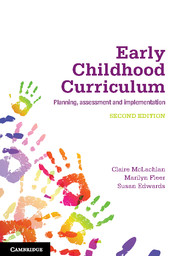Book contents
- Frontmatter
- Contents
- About the authors
- Acknowledgements
- 1 Introduction
- 2 Theory, research and the early childhood curriculum
- 3 Development and learning – how views of development shape how curriculum is framed
- 4 Curriculum as a cultural broker
- 5 Interpreting early childhood curriculum
- 6 Cultural-historical curriculum in action
- 7 Curriculum as a conceptual tool: Observation, content and programming
- 8 Assessing children and evaluating curriculum
- 9 Content knowledge: The sciences, maths and numeracy
- 10 Content knowledge: Language, literacy and ICT
- 11 Content knowledge: The arts and health, wellbeing and physical activity
- 12 Conclusions
- Glossary
- References
- Index
6 - Cultural-historical curriculum in action
- Frontmatter
- Contents
- About the authors
- Acknowledgements
- 1 Introduction
- 2 Theory, research and the early childhood curriculum
- 3 Development and learning – how views of development shape how curriculum is framed
- 4 Curriculum as a cultural broker
- 5 Interpreting early childhood curriculum
- 6 Cultural-historical curriculum in action
- 7 Curriculum as a conceptual tool: Observation, content and programming
- 8 Assessing children and evaluating curriculum
- 9 Content knowledge: The sciences, maths and numeracy
- 10 Content knowledge: Language, literacy and ICT
- 11 Content knowledge: The arts and health, wellbeing and physical activity
- 12 Conclusions
- Glossary
- References
- Index
Summary
Learning intentions
This chapter is intended to help you learn:
that cultural historical theory is useful for understanding children’s learning in the context of their cultural and family experiences
that children’s cultural and family experiences can provide the basis of curriculum provision
that a cultural-historically informed approach to curriculum is different to enacting multiculturalism as a ‘tourist approach’ (Derman-Sparks 1989) in early childhood settings.
This chapter will help you answer the question posed by Gemma about curriculum in our opening scenario: ‘Isn’t that when you talk to parents about what they want in the curriculum?’
In the previous chapters of this book it was proposed that teachers need to understand how curriculum is constructed: by teachers in collaboration with children, families and communities. We begin here with a discussion of the ways teachers make decisions about curriculum. Cultural-historical theory is used as a framework for supporting educators’ work with young children in culturally respectful ways. We examine the importance of moving beyond notions of multiculturalism to understandings of how development and learning are enacted in different cultural communities, and the need for early childhood curriculum to enable learning for all children. This chapter also explains how teachers need to have an understanding of the knowledge children bring to their learning and be able to identify opportunities for extending children’s learning.
- Type
- Chapter
- Information
- Early Childhood CurriculumPlanning, Assessment, and Implementation, pp. 69 - 82Publisher: Cambridge University PressPrint publication year: 2013



